MapleStory is an online video game that used to have an active community. Unfortunately that's no longer the case. In this post I'd like to dissect how MapleStory turned from hot to not, and answer the question: "How did the game become such a desolate husk of its former self?"
Background
MapleStory is a 2D MMORPG (Massively multiplayer online role-playing game) that used to be very popular back in the mid-to-late 2000s and early 2010s. A player would choose one of the four explorer classes: warrior, bowman, magician, or thief.
Players would kill monsters or do quests to get experience points (EXP). Gathering up enough EXP would result in players increasing their character level (Lv.) which allowed them to utilize new skills and equipment, and thereby access more dangerous and interesting areas of the game.
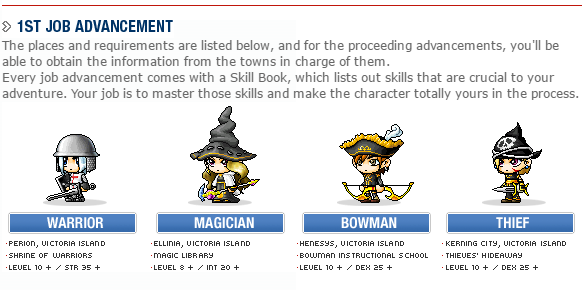
MapleStory's fall in popularity
MapleStory used to have a large player base in the European version called eMS (europe MapleStory) that I happened to play. I unfortunately can't find statistics from the mid-to-late 2000s on the size of this player base. If you look at graphs like this one you might get the impression that the player base is growing, but this is not the case. MapleStory wasn't actually on Steam - the video game distribution service - before, so this apparent growth is partially due to adoption on Steam.
At the time of writing (a weekend) I installed Windows and downloaded the game. I logged into my old account on the main European server (called Luna). It's mostly empty, I only see a fraction of the people at the usual hangout spots. Apparently the main hangout spots have changed to "Vanishing Journey", but I can't access this.
Each MapleStory world has a set of channels so multiple players can be on the same map without interfering with each other. Channel 1 would be the default gathering place for players. There are no people in the Free Market area on channel 1 anymore. The previously popular village of Henesys and its associated Henesys Hunting Ground 1 is mostly empty. Here's a video of how it used to be before.
Reboot
There is however a newer server called "Reboot". I decided to take a look. This server is far more active. There are actual players here, about 30-40 in Henesys on channel 1, but the side maps are empty. All-in-all, the general impression I get is that there are far fewer people logged into the game than when MapleStory was in its golden era of the mid-to-late 2000s.
North America
It's now possible to join the North American (NA) servers from Europe, so I decided to log into its Reboot server since it showed the most activity - there are bars that indicate server load when selecting worlds. From these it's readily apparent that the Reboot servers in NA and Europe are by far the most popular.
I logged in, made a new character, and went to Henesys. Not much different from the EU server. A little fewer people actually, about ~20 or so.
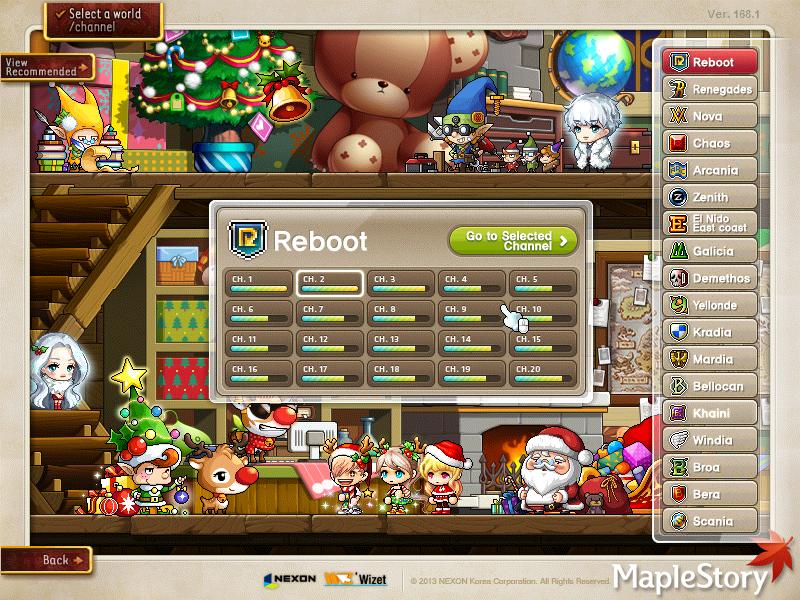
I don't know if the above image is indicative of relative load on different worlds, or whether that server has a certain absolute load depending on its own capacity. Who knows, perhaps different servers have different hardware and thus varying capacities for hosting players.
What made MapleStory work so well?
The game's appeal was its social aspect - at least in my experience. As a kid I would wake up, play MapleStory for 1-2 hours before school, talk to friends at school about MapleStory, and then go home to play MapleStory again. Whilst playing I would chat with various people that were online. These were people from all over Europe.
A typical player would be part of a guild which had a limit of 200 members. This number is incidentally quite close to Dunbar's number (150) if you count that not all guilds are full, and there often are some inactive players in a guild.
Grinding away at monsters or doing quests while in a guild made players able to interact with a relatively big group of people at all times. In addition, all your friends would also show up in a separate chat. This meant that you could go do some interesting thing whilst also chatting with guild members and friends, which created this incredibly engaging social environment where you're with other people and you have something to do and chat about together.
MapleStory: A chat room in a virtual world
I remember fondly just grinding away at Ghost Ship 2 whilst discussing anything and everything with guild mates and friends. I noticed that my time was spent grinding and chatting. The grinding was automatic, it's all muscle memory. It was really the chatting that was engaging.
Occasionally, we would have guilds warring against each other for controlling good monster grinding spots. This could be done by KSing (Kill-Stealing). If two or more players attacked the same monster then the monster's EXP would be distributed among those players. It was also really dissatisfying to have hit a monster 3-5 times, to then be killed by someone else in a single shot, and so we had KS wars where players annoyed each other until one party capitulated.
Angsty teenage gang wars
We would also gang up on people and use the "fame" system to decrease people's fame score. This was a great deterrent, as fame indicated to others whether you were likely to scam them, or just be an asshole. People with low fame were just less easily considered worthy of socializing with by others.
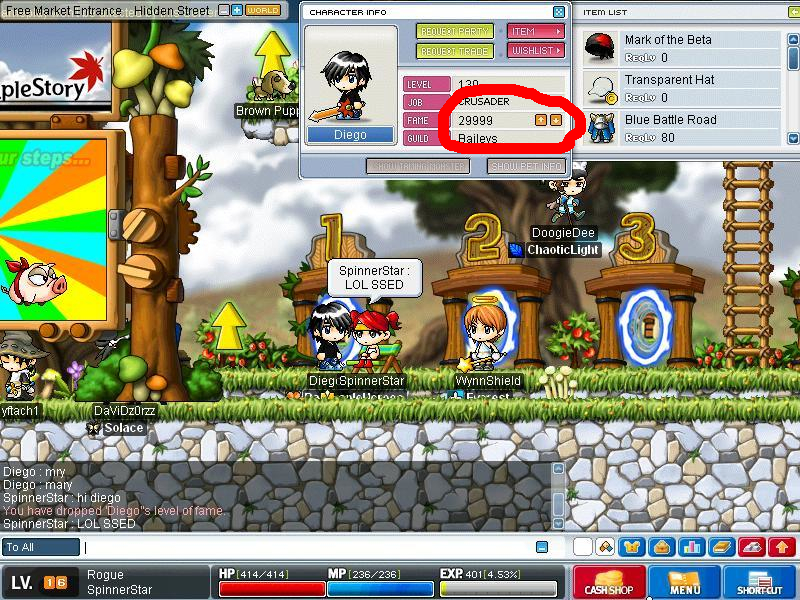
This all sounds so petty and insignificant, but as a young teenager this is your "tribe", and becomes incredibly meaningful, and really kept me - and I think part of the younger player base - engaged.
FreeTime2Win
Young people also tend to not have a lot of money! The game was play2win, there was no way for money to affect gameplay - barring non-sanctioned transfers. This too made the game feel like there was an air of genuineness to it. The Lv. and wealth you attained stemmed from time and effort spent in the game.
The way Nexon (the company running MapleStory) earned money was via its "Cash Shop". Here, only cosmetic items were available. One exception was pets, which could be made to pick up items for you, but this wasn't something that made the game hugely imbalanced between the have and have-nots.
First signs of decay: Loss of orthogonality
When I started playing MapleStory there were 4 broad classes to play: warrior, bowman, magician, and thief. These are called "explorers". Explorers have complementary skills that incentivize partying up together, a game mechanic in which killing monsters shares EXP with the party members. There were also "Party Quests", in which one would party up and talk to an NPC to begin a Party Quest. Here, you would solve puzzles together and get EXP for doing so, you would also defeat monsters. I remember the Ludibrium party quest needed a crossbowman (bowman subclass) to hit a box that was too far for others to reach.
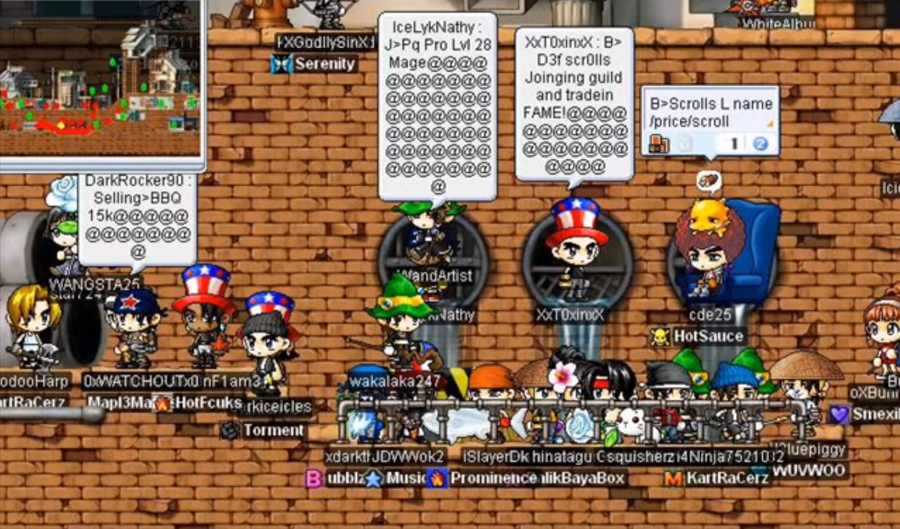
Anyway, those 4 classes segmented the view of the player world into 4 managable categories.
Then pirates came. They are the 5th explorer class, but they did not appear orthogonal to the other 4 classes. The two subclasses of pirates are brawler and gunslinger, but those are essentially a short-range warrior and a bowman but with guns, respectively. In other words: pirates didn't bring anything new and unique to the table. Pirates were added on the 12th of November, 2008.
Nonetheless, this worked fine, I ignored pirates, but then a whole new parallel to the explorer class arrived: Cygnus Knights. These characters could only level up to Lv. 120 - unlike explorers which could go to Lv. 200. These were added on the 29th of July, 2009.
The cool thing about the Cygnus Knights was that the level of your Cygnus character would affect some property of your explorer character, so a lot of players were incentivized to have a level 120 Cygnus on their accounts. This caused an explosion in people playing on Cygnus.
The addition of further classes didn't stop here, oh no, Aran was added, then came Evan, Dual Blade, Resistance, Mechanic, Cannoneer, Mercedes,... The number of classes grew from the original 4 explorers into a bloated list of over 30.
Effects
This huge amount of classes had the effect of making the game far too complex. The traditional 4 classes all had subclasses, but because you start by knowing the 4, it compartmentalizes each class's inner subclass complexity.
Losing orthogonality meant that the game lost its player recognizability. It lost its archetypes. As a result, the value of "being a mage", or "being a warrior" went down. Identity among players was made to be insignificant. As a game where the social aspects dominated player retention, this - in my opinion - really caused a sense of not belonging anymore. What worth is my class if it's pretty much like all the others?
A short-term profits racket 🤑
It occurred also around this same time that the game lost its play2win philosophy. Nexon started selling 2x EXP cards in its cash shop. The cash shop used to be for cosmetic items only (except pets), which players could buy using real money.
This 2x EXP card would give players 4 hours of 2x EXP, and it would stack with server events! I remember using them myself whenever there were day-long, server-wide 2x EXP events in order to get 4x EXP. This really helped speed up levelling, as levelling was incredibly tough above around Lv. 80. It would take days of grinding to level up, but that made it all the more fun to just exist inside the game and enjoy the journey.
Nobody was concerned with the end-game because it felt unattainable. To see a level 120+ player was a sight to behold. Truly, some incredible effort has gone into that. But alas, the 2x cards started watering down this perception.
Poison the well, sell the cure
MapleStory has a "scrolling mechanic", where you could enhance equipment with additional stats by using a scroll. A scroll could fail with a given probability, and a single item could only be scrolled a few times. For instance, there is a 10% (chance of success) scroll that gives +5 ATT on one-handed swords, while the 60% scroll only gave +2 ATT. In other words the choice of scroll % is a risk-reward tradeoff.

Nexon thought it'd be a good idea to sell items to affect the scrolling mechanics. For instance they sold Shielding Ward using Nexon Cash (NX Cash) - something you had to pay for with real currency. This item would prevent "dark scrolls" from potentially destroying the item you're scrolling. This, in effect, bypasses all failed attempts, and gives an advantage over other players. Players without Shielding Ward would have to acquire fresh items and scrolls and perform the scrolling again. This is an expensive (in-game money) endeavor. Thus the effective end-result of players paying for Shielding Ward is converting real currency into in-game currency.
An additional mechanism got added to items called "potential". Again, Nexon started selling so-called "cubes" to affect this mechanic.
I think you get the idea. Nexon introduces a new mechanic and then sells you the solution to avoid its tedious aspects.
The Big Bang Letdown
A huge overhaul called the Big Bang was introduced that changed a large portion of the game. The maps got changed and the EXP required for levelling up got reduced drastically. In fact I recall new characters being able to go to Lv. 70 within a day, a day! This used to take months of casual play. This destroyed the pacing of the game. The slowness of MapleStory from before the Big Bang update made players enjoy the journey more. I certainly did. I wasn't concerned with attaining Lv. 200, because that felt unattainable.
Another thing to note is that the map changes were really awkward. It streamlined the world too much, making it feel designed instead of organic. One example thereof is how Victoria Island changed to have a central hub where Sleepywood used to be located. It just felt too easy to navigate, too simple.
Compare the before-and-after pictures.
Before

After
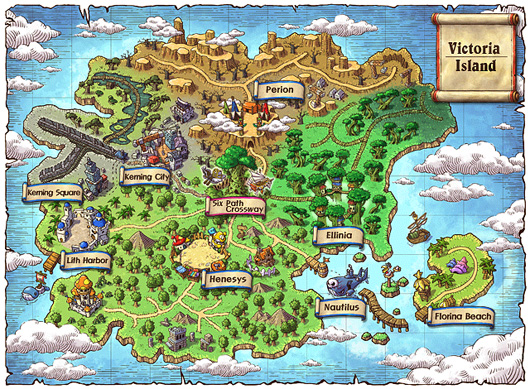
Sleepywood used to be a dangerous place for beginners, so those below about Lv. 20 would avoid going there and would instead walk around it to get to other towns. With the advent of Big Bang this was changed to the Six Path Crossway which removed the adventurous aspect of exploring the island.
Yet another change is that of Henesys Hunting Ground 1, here players of all levels would come to show off their skills to noobs and just hang out. It felt like a casual chat lounge. Socializing here was no longer possible after Big Bang because they changed the design that centered around a little building which players could sit on top of without being attacked by monsters.
Backpedaling: Reboot servers
Nexon realized their player base was dwindling, and decided to create a new server called Reboot. They thought that the reason for declining players was fundamentally due to trading, so they removed that and kept all the other stuff... I don't get the appeal. Trading was cool! The Free Market was awesome to be at, and to get anything from other players. I think Nexon totally missed the mark in what made MapleStory bad. It's not trading. If anything trading is part of what made the game good because it enhanced that vital social aspect of the game.
Maybe I'm just getting old
Here we are now. The old MapleStory is just dead. I'm 28 now so maybe I just outgrew the game. While I think that's partially true, it's also true that the game just messed up its own formula. For what reason? We can all speculate that the Global Financial Crisis might have caused this, but the revenue data I looked at is insufficient; I unfortunately can't find any revenue data or stock prices from before 2008 on this so I can't tell if their revenue decreased compared to 2007.
Lessons to learn from MapleStory
To answer the question of how MapleStory become a desolate husk of its former self, here's a list of things of what I think Nexon did to accomplish that.
- Let short-term profits destroy that which made it good (The game was good as non-pay2win, as observed from players' preference of Reboot servers)
- Made too many variants, didn't stick to easily characterized archetypes (Too many classes in the game)
- Overhauled something that was working well. Didn't iterate (Big Bang style updates)
- Didn't discard what didn't work (Undoing Big Bang, even partially, instead of trading - it seriously baffles me as to why they decided that banning trading was a good idea at all on their "Reboot" servers)
- Ignored that which really incentivized people (People came to MapleStory for the community, not for reaching Lv. 70 within a day)
Around the web
If you go into any discussion of MapleStory, you'll find previous players reminisce about the golden era of MapleStory. Their comments mainly point out the importance of the game's social aspect.








And so all good things come to an end
I have fond memories of this game and the friends I've made. I unfortunately lost most of those friends due to leaving MSN for Skype back in the day. It saddens me that I didn't take better care of keeping contact information. I wonder where they are in life now.